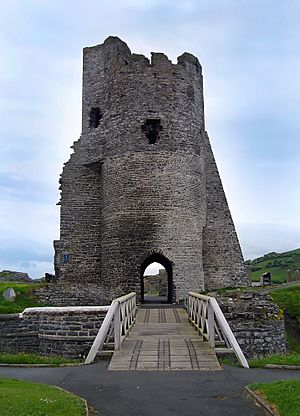Aberystwyth Castle facts for kids
Quick facts for kids Aberystwyth Castle |
|
|---|---|
| Part of Ceredigion | |
| Aberystwyth Wales | |

Remains of the north tower gateway at Aberystwyth Castle.
|
|
| Coordinates | 52°24′48″N 4°05′23″W / 52.41324°N 4.08968°W |
| Type | Diamond-shaped concentric castle |
| Site information | |
| Controlled by | Aberystwyth Town Council |
| Condition | Ruin |
| Site history | |
| Built | 1277–1289 |
| Built by | Later work attributed to James of Saint George |
| In use | Open to public |
| Materials | Siltstone |
| Demolished | 1649 |
| Events | Welsh Wars English Civil War |
|
Listed Building – Grade I
|
|
Aberystwyth Castle (Welsh: Castell Aberystwyth) is an old fortress in Aberystwyth, Ceredigion, Mid Wales. It was built by King Edward I of England in the late 1200s. This happened after the first war against the Welsh. The castle replaced an even older fort nearby.
During a big Welsh uprising led by Owain Glyndŵr, the Welsh took control of the castle in 1404. But the English got it back four years later. In 1637, King Charles I of England turned the castle into a place to make coins, called a Royal Mint. It even made silver shillings! Later, in 1649, the castle was partly destroyed by Oliver Cromwell so it couldn't be used again. Today, it stands as a ruin.
Contents
History of Aberystwyth Castle
The First Castle (Old Aberystwyth)
Around 1110, a Norman lord named Gilbert de Clare built an earlier castle. It was a "motte and bailey" castle. This means it had a big mound (motte) with a tower and a walled yard (bailey). It was about a mile south of where the current castle is. People called it Tan-y-castell or Old Aberystwyth.
In 1116, Gruffydd ap Rhys, a Welsh king, tried to capture it but failed. He succeeded in 1136 with help from Owain Gwynedd. They burned it down. Owain Gwynedd gave the castle to his brother, Cadwaladr. But Cadwaladr later tried to harm another Welsh king. So, Owain Gwynedd sent his son to burn the castle again in 1143.
The castle was rebuilt and made stronger with stone. After a few different owners, the Welsh prince Llywelyn the Great took it in 1221. He tore down that castle and built a new one in its place.
Building the Current Castle
The castle you see today was built in its current spot by King Edward I of England. This happened in 1277 after his first war against Llywelyn ap Gruffudd, Llywelyn the Great's grandson. The Welsh took the castle in 1282 during another war. They burned both the castle and the town.
A master builder named James of St George helped finish the castle in 1289. However, it faced many attacks during a revolt by Madog ap Llywelyn in 1294–1295.
Later Years and Royal Mint
By 1307, the town of Aberystwyth was doing well. Its Welsh name was Llanbadarn Gaerog, meaning "Fortified Llanbadarn." But by 1343, the castle was in bad shape. Parts like the main gate, drawbridges, and kitchen were falling apart.
In 1404, Owain Glyndŵr captured the castle during a big Welsh uprising. A treaty between Glyndŵr and the King of France was even signed there. Four years later, the English took it back. It then became an important government building.
In 1637, King Charles I of England turned the castle into a Royal Mint. This was a place where coins were made. The castle started making silver shillings. The person running the mint even raised a group of soldiers for the King during the English Civil War. The mint closed during the war. It was then used as a storage place for silver and lead. Finally, Oliver Cromwell ordered the castle to be partly destroyed in 1649. This made sure it could not be used as a fort again.
Castle Design and Structure
Building the current Aberystwyth Castle started in 1277. This was during King Edward I's first war in Wales. Other castles like Flint, Rhuddlan, and Builth Wells were also being built at the same time.
The inside part of the castle, called the inner ward, was shaped like a diamond. It was a "concentric castle." This means it had walls within walls for extra protection. It had a main gatehouse with two D-shaped towers. There were also towers at each corner of the walls.
The outer ward had another gatehouse with two D-shaped towers. It also had a barbican, which is a fortified gateway. There was a ditch carved into the rock and a large outer wall with more towers. This design made the castle very strong and hard to attack.
Images for kids






